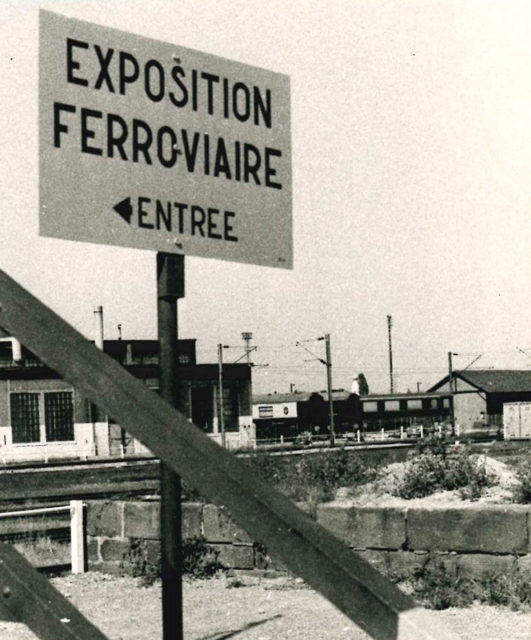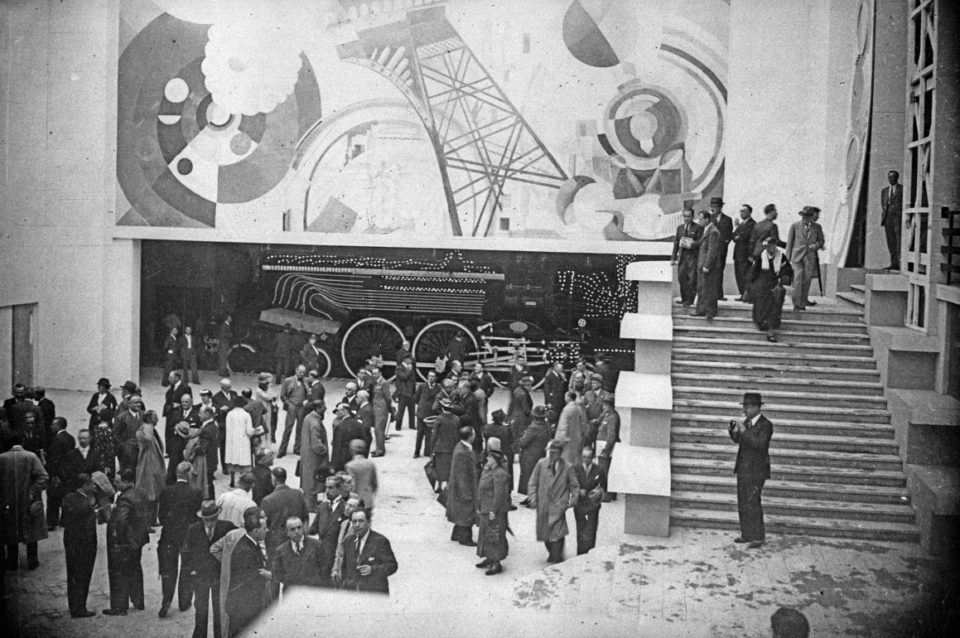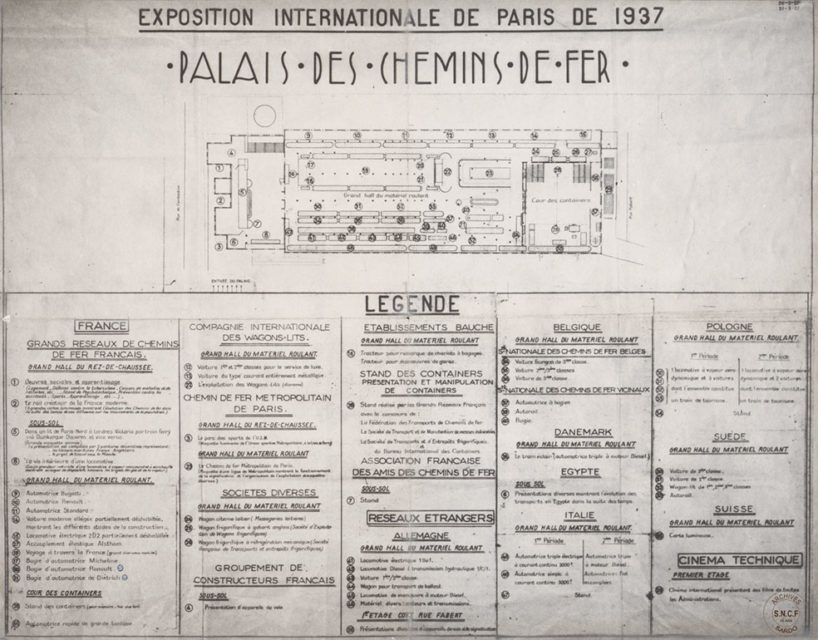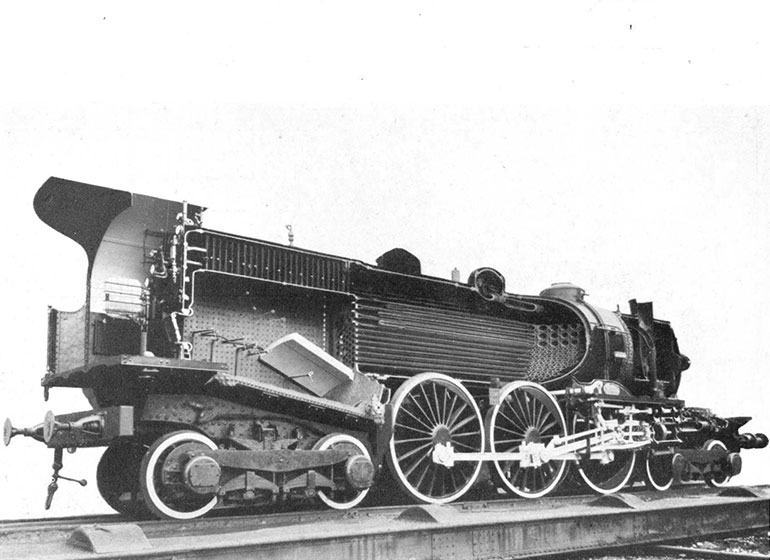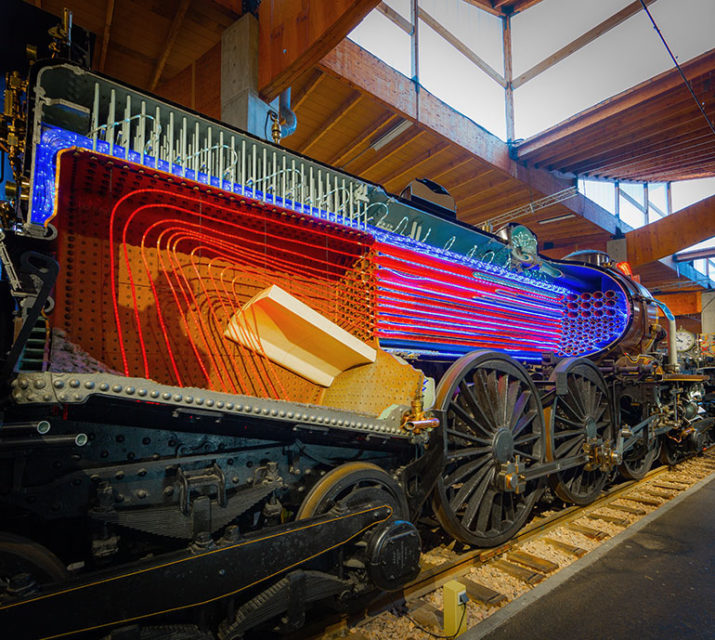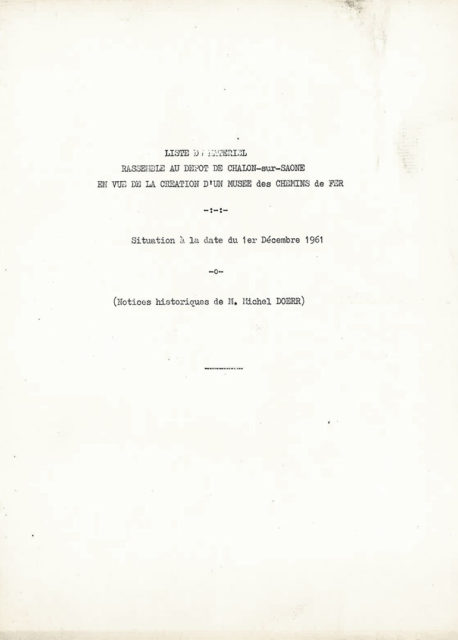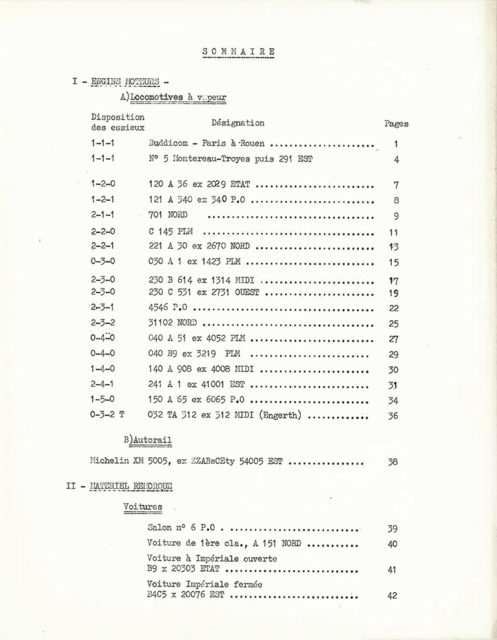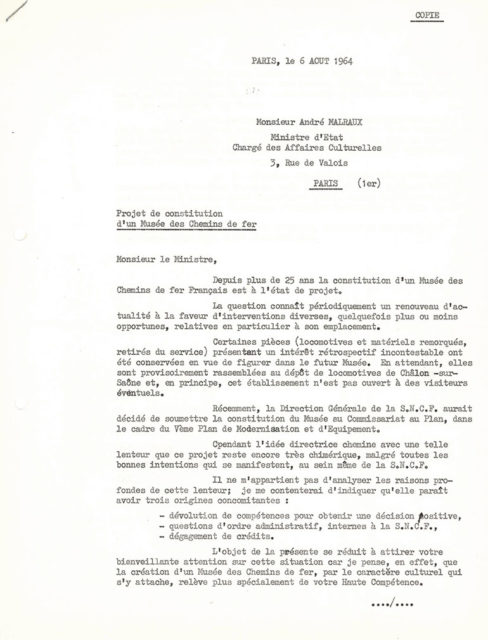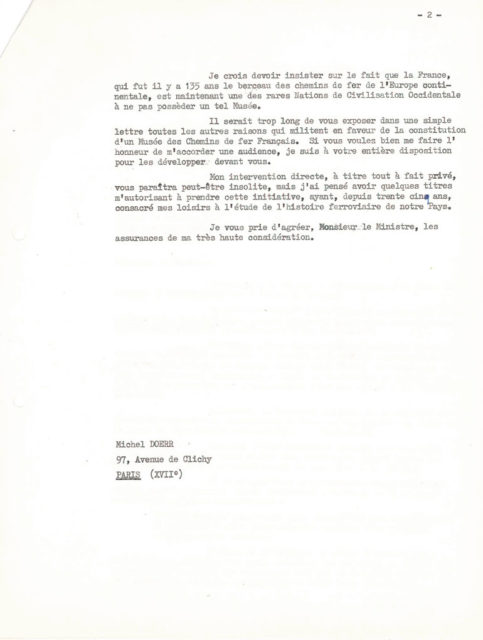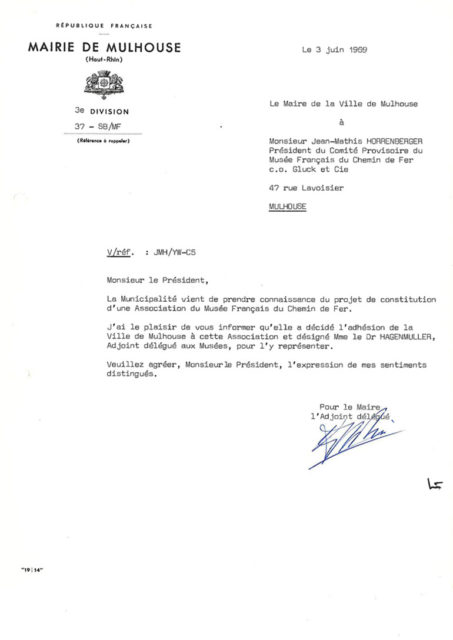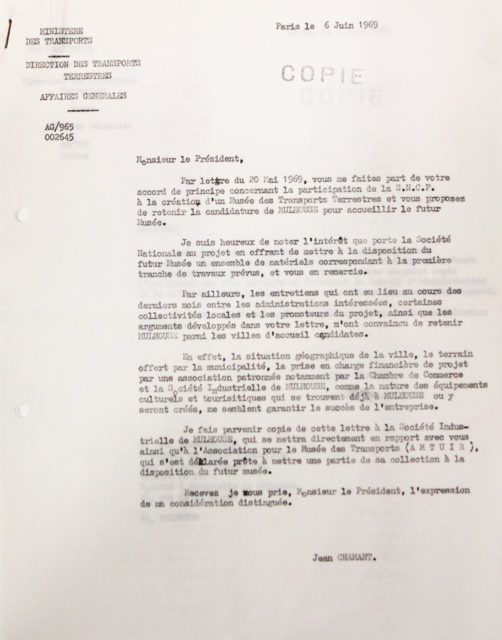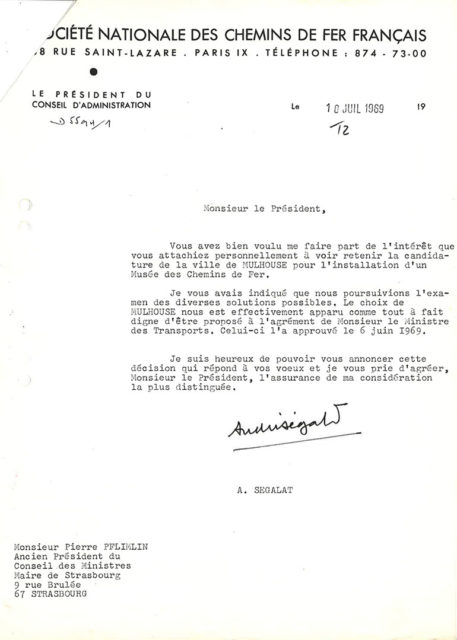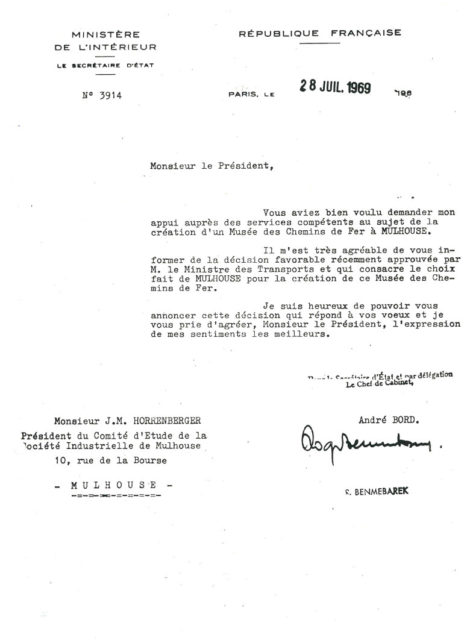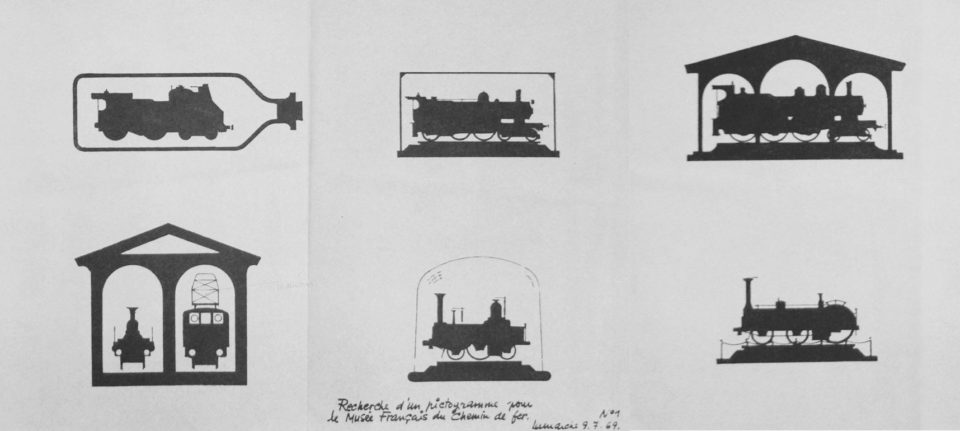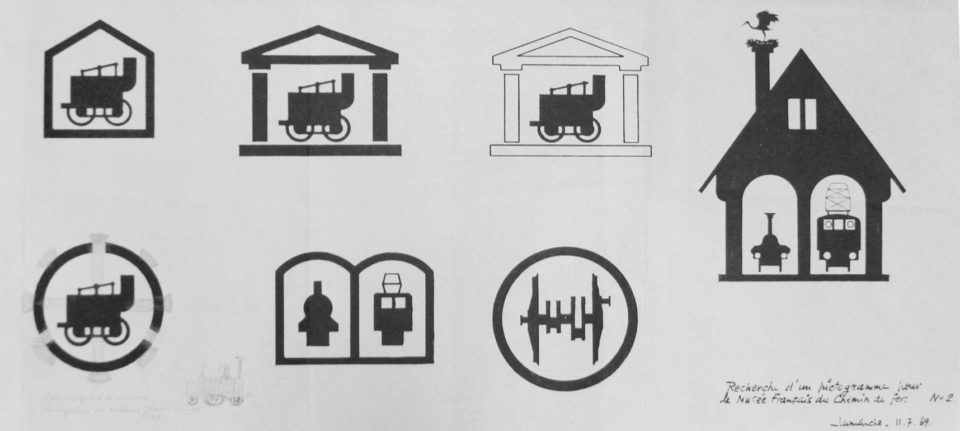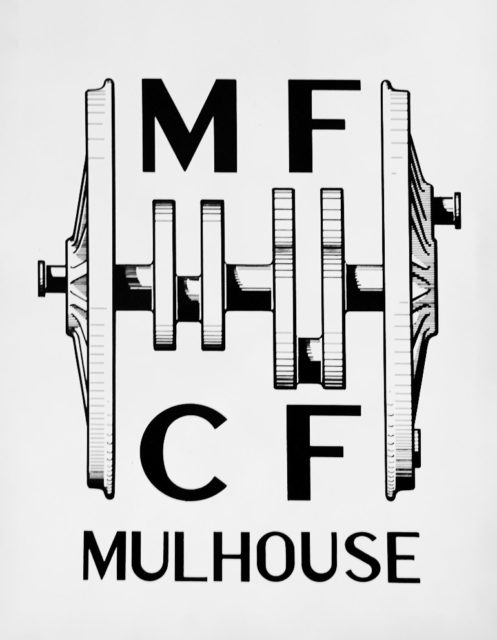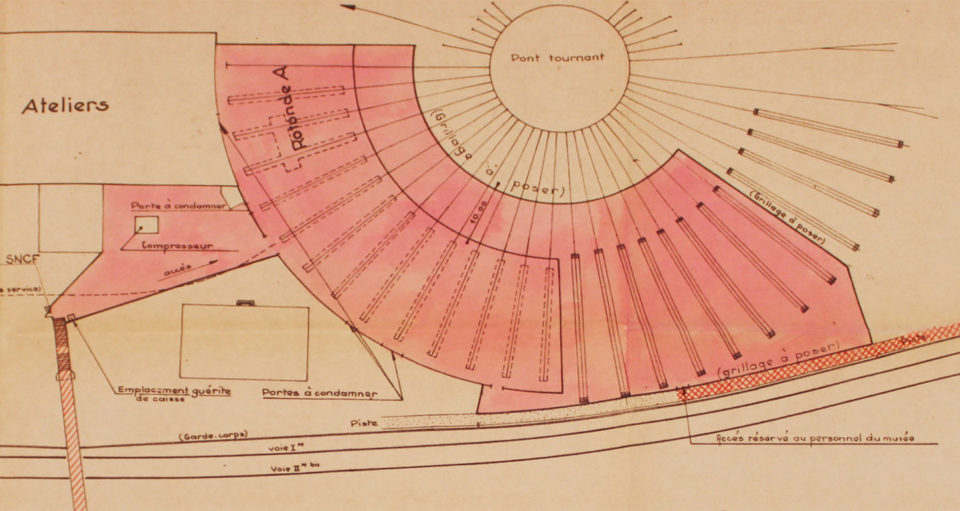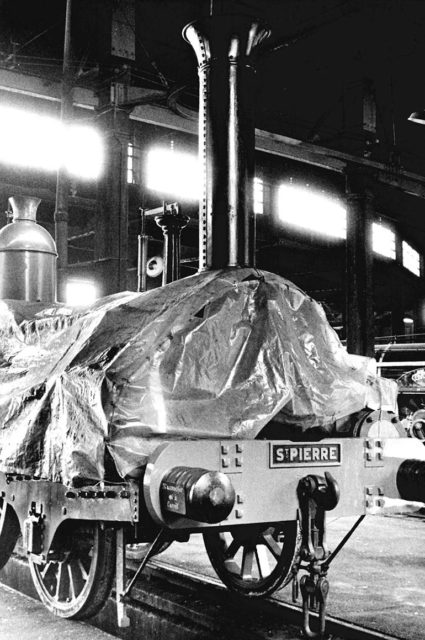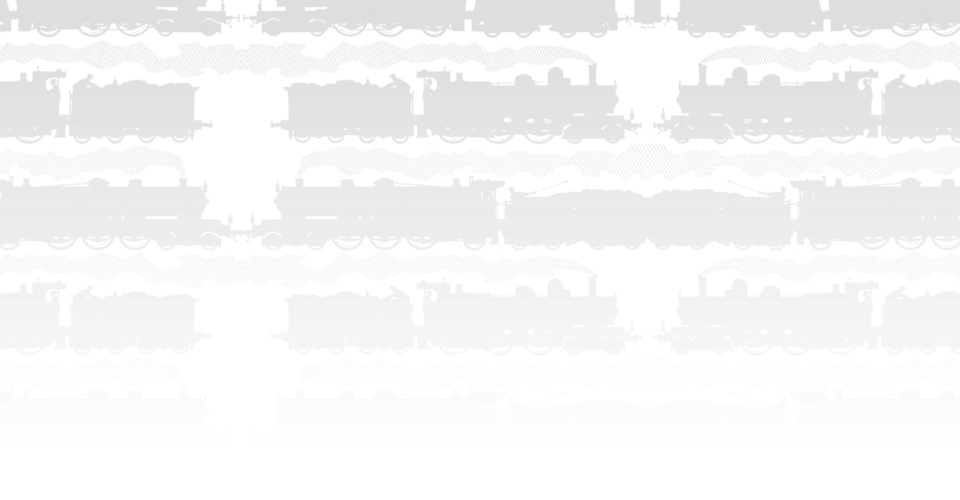
A collection
in movement
From the early 20th century to the inauguration of the French Railways Museum in June 1971, discover the successive stages of the birth of an original museum that is firmly rooted in its home: Alsace.
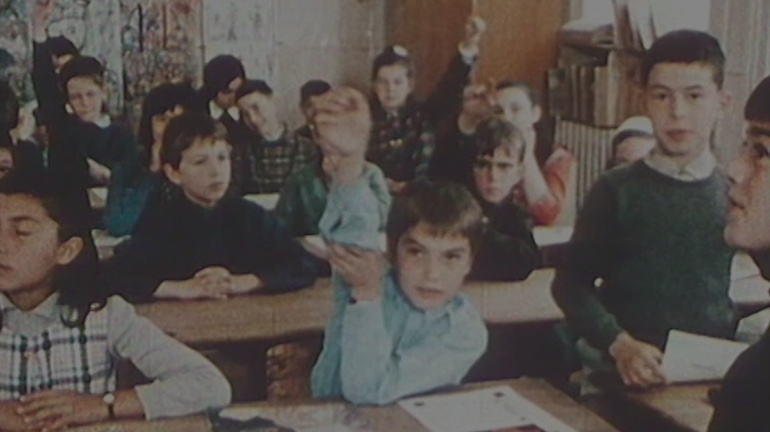
Sartrouville, 1969. In a primary school classroom, pupils are imagining the means of transport of the year 2000. Watched by the camera of Dim Dam Dom, a programme produced by ORTF, the children take turns at describing their drawings, with comments that are both sensitive and visionary. The moon landings, Boeing 737, Concorde, Eddy Merckx winning the Tour de France: in the field of transport, 1969 was not an ordinary year. Railways were also very much part of that picture, with their own new developments: Mistral 69 passenger cars and the early CC 6500 series of electric locomotives designed by Paul Arzens.
But these innovations left room for much nostalgia. Indeed, how can one forget that those were the dying days of passenger trains with steam locomotives? It was particularly in order to counter that gradual decline of a whole period in the history of railways that the organisation for a French railways museum was set up in Mulhouse. Inaugurated in June 1971, the museum was in reality the result of thinking that had started in the early 20th century.
The French Railways Museum was thus opened to the public in the half roundhouse of the Mulhouse North depot, rue Josué Hofer. It was the beginning of a history that is still being written every day.
A collective
memory
Shortly before World War I, tourism was picking up speed in France. The big rail companies continued to deploy their publications and attend national and international exhibitions. Monuments and cultural venues served by the major networks eventually became selling points.
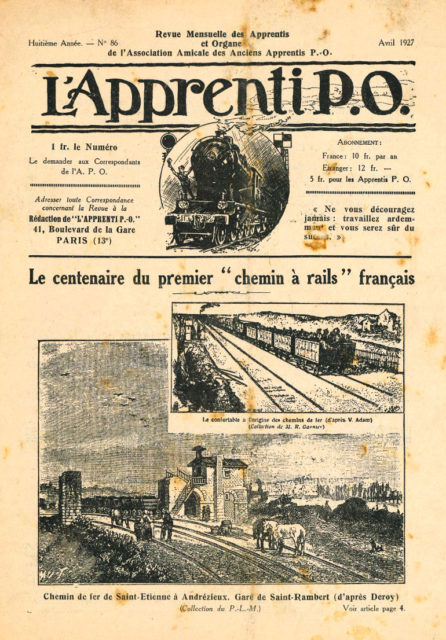
We might think with a smile that the first French “railway” was a dream: but it did exist, it left vestiges, memories and relics, a bridge, a platform, to act as “witnesses” and mark the road to progress.”
– F.L. in Revue Mensuelle des Apprentis et Organe de l’Association Amicale des Anciens Apprentis P.O., no 86, April 1927
In the 1920s and 1930s, rail companies gradually set up advertising budgets. In April 1927, in its monthly magazine, the Compagnie du Paris-Orléans encouraged its apprentices to sign up for the railway history project. As it commemorated 100 years of the first railway line between Saint-Etienne and Andrézieux, the company reminded the public that history looks back in time, and also in the present and future. Each railway worker contributed individually and collectively to the project.
1937:
an instructive
locomotive
The International Exposition of Paris was inaugurated in 1937. The Railways pavilion was located not far from Invalides station, and allowed rail companies to show their latest innovations. At the entrance to the pavilion, a locomotive decorated with a large Robert and Sonia Delaunay fresco drew the eyes of visitors. This was the 232 Baltic no 3.1102 Nord, which can be seen today in the Cité du Train. Its particularity? That of being cut in halves for explanatory purposes and having luminous devices simulating the paths of gas and steam. Come closer, and take a good look at the inner life of a loco!
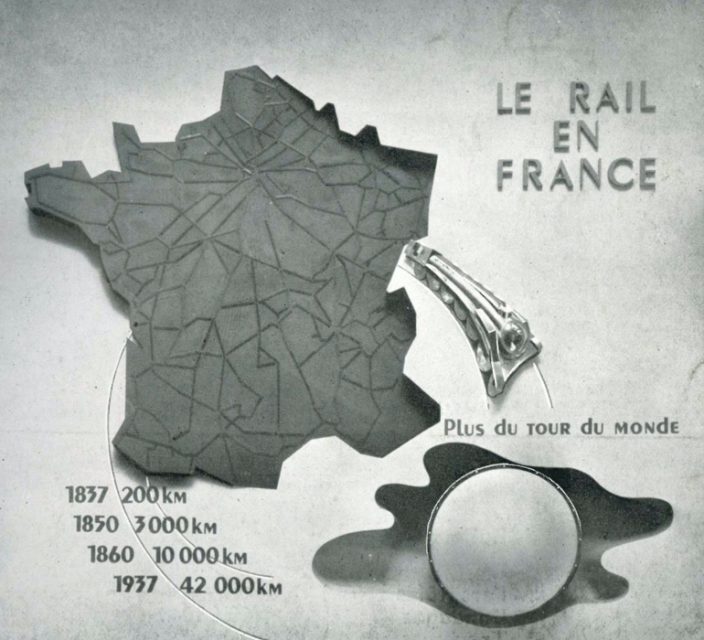

The SNCF was founded in 1938,
and the museum project came back to the fore before the war
“Under the decree law of 1937, the five large railway companies of the country were merged on 1 January 1938, giving rise officially to the Société nationale des chemins de fer français. At the time, French rail employed 515,000 workers and had 42,700 km of tracks.”
1 January 1938. The Société Nationale des Chemins de Fer was founded. Five years later, in 1944, the idea of setting up a museum devoted to railways was back. The Association Française des Amis des Chemins de Fer (AFAC) founded in 1929 became a major defender of this great plan. Paris was believed to be the ideal city for the new establishment. But the project, which was suspended in 1949 mainly for financial reasons, was finally put off to “better times”.
The Crampton as a monument
From steam
to turbotrain
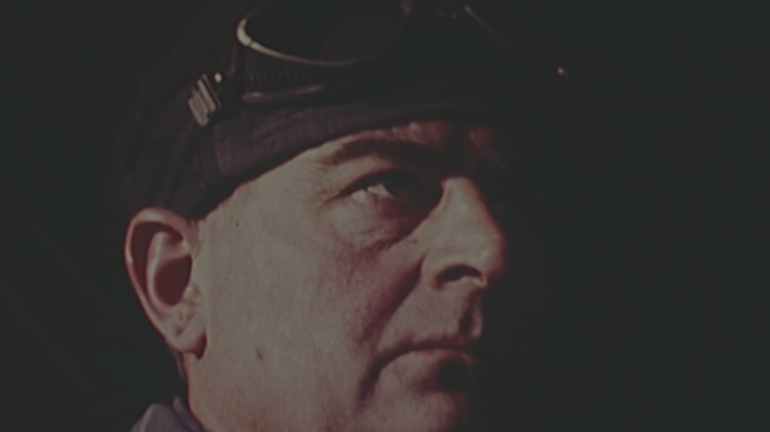
In the 1960s and 1970s, steam locomotives were gradually phased out. As diesel and electric engines gained ground in the system, French people simultaneously saw trials with hover trains and the development of Turbotrains, the ancestors of TGVs. The INA film titled Dernière Pacific is an account of the end of that transition period, when nostalgia was mixed with experimentation.
The driver climbs out of his cabin and replies to the questions from the journalist with some emotion. While he recognises that “you cannot fight modernism”, he also reminds viewers of what steam engines meant to him: “a team life” and “love for the machine”.
A refuge
in Chalon
The demise of steam did not only affect railway employees who worked on board trains. It also resulted in a decrease, and in some cases in the conversion of the activity of railway workshops and depots. These were used to house equipment, and were complex architectural structures. Roundhouses, turn tables, pits, fuel magazines, water and sand are some of the elements that could be found in these buildings inherited from the early rail companies. That was so of the depot in Chalon-sur-Saône, which, in the early 1960s, was given a new function, that of conserving historic rolling stock that would move to the museum a decade later.
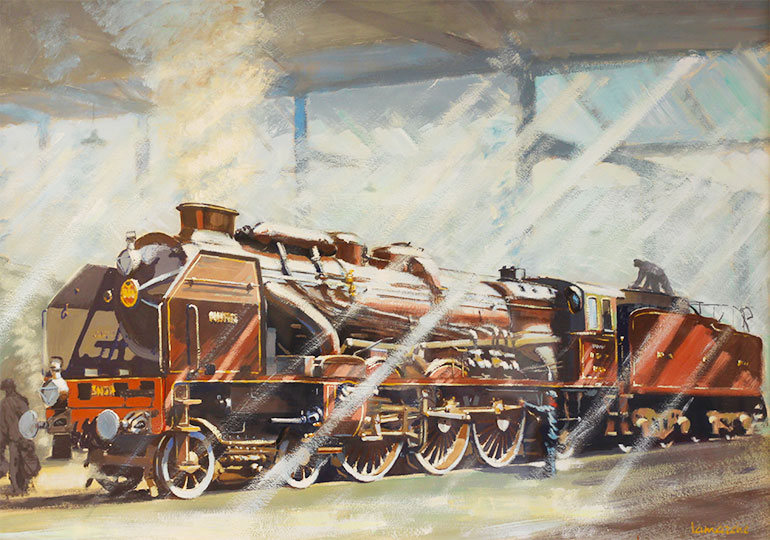
Genesis of an
inventory
In 1961, Michel Doerr (1919-1995) provided a “list of equipment brought together in the depot in Chalon-sur-Saône with a view to setting up a railways museum”. 70 years after it was established, this document describing the equipment preserved as heritage by the Equipment Department of SNCF has in turn become a heritage asset. It laid the foundations of the future museum and also told of the commitment of a man who was a railways specialist and a singular artist, who, according to the author and journalist Jean des Cars, succeeded in building up “one of the finest collections in the world”. In 1964, the man who is affectionately called “l’ami Doerr” contacted André Malraux, then Minister for Culture, in order to put the collection on display. His way of presenting his approach as “unusual” was not insignificant. The Ministry for Culture had been set up five years earlier in 1959, and the minister chose to direct his efforts towards artistic museums. The Ministry for Transport thus became the leading State partner.
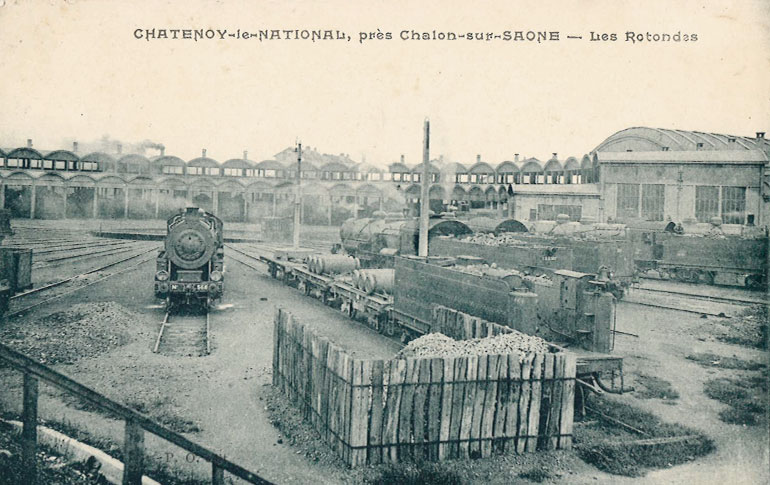
The railways of yesteryars… For a French railways museum
Museums have not been devoted to painting because painting was dead, no more than those devoted to porcelain or to any other manifestation of the human spirit; their essential role is to show the generations of visitors what they owe to those who went before them. That will also be true of the Railways Museum, which will demonstrate through tangible facts the relationship between the continuity of principles and achievements in the development of a railway system that is ever more efficient, and the almost regular changes that result from advancing techniques which are perpetually renewed”.
Daniel Caire
editor in chief of AFAC, 1965
11965 marked a turning point in the plan to set up a French museum devoted to the railways. That was the year when AFAC published a catalogue made up of “historical entries on equipment brought together with a view to setting up a Railways Museum”. The document, drafted by Michel Doerr, presented the 37 locomotives, carriages and wagons that were preserved at the time in Chalon sur Saône. Right from the foreword, Daniel Caire, editor in chief of AFAC, put down the markers of unwavering thought: the railways heritage is human, artistic and technical, and is ever changing. Given that, how is a collection in movement to be conserved, displayed and showcased?
Five years on, in 1970, in an article in the magazine Equipement,-Logement-Transport titled “Towards a French Railways Museum”, Michel Doerr and André Portefaix, Chief Engineer at SNCF, suggested several solutions. For the two men, “[…] we need to think of a museum, especially since museum science has made progress that makes it possible to effectively bring together the appeal of a show and the value of information”.
An exceptional reader:
Jean-Mathis HORRENBERGER (1929-2012)
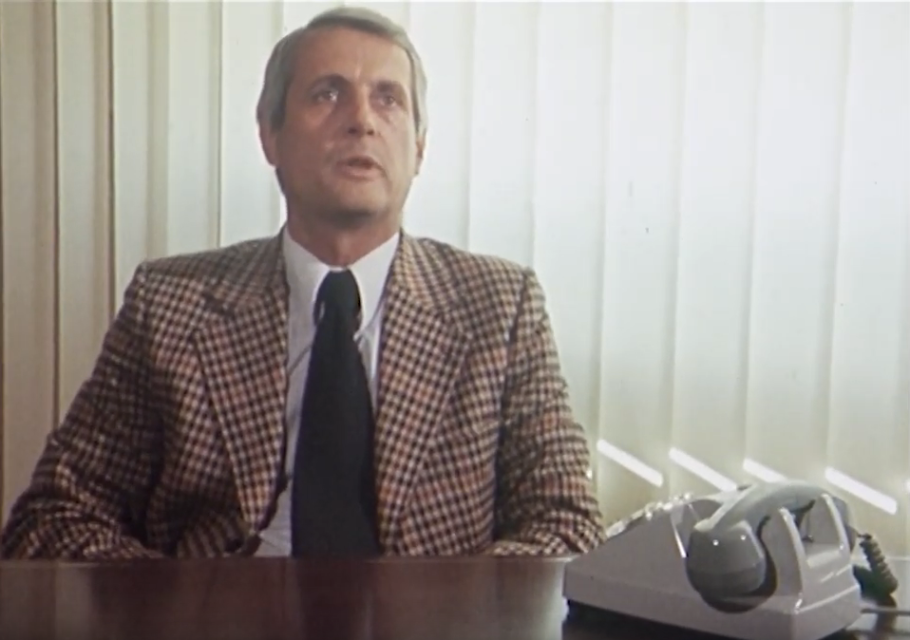
The book Le Musée Français du Chemin de Fer : une utopie devenue réalité published in 1997 is a valuable account of the life of its author, Jean-Mathis Horrenberger. He describes his childhood in Thann, marked by travelling on board the simple railway carriages of Alsace. Above all, he recounts his first aesthetic shock one evening in 1936 in Marseille Saint-Charles station, when a Mountain 241 locomotive pulled in. He was seven, and paid leave had been instituted.
That was the unforgettable moment when Horrenberger caught what he himself calls a “virus”: that of railways. After World War II, the youngster, later a senior manager of a textile factory in Alsace, avidly read La Vie du Rail and dreamt of joining AFAC, whose editor in chief, Daniel Caire, became his tutelary figure. The publication of the catalogue in 1965 was the trigger for what would eventually be the epic of the creation of the museum.
The obviousness
of Mulhouse
Nine months after his reading the AFAC catalogue, Jean-Mathis Horrenberger officially contacted its President Georges Manas. Nine months of gestation for drafting a complete and resolutely Alsatian project. With its rich industrial and railway past and its position at the crossroads of Europe, the cité du Bollwerk was the ideal location for a museum devoted to railways. The provisional committee responsible for defending the choice of Mulhouse promoted by SIM, already made up of local personalities and members of SNCF, thus offered an additional argument: the “mill house” would also be the home of trains.
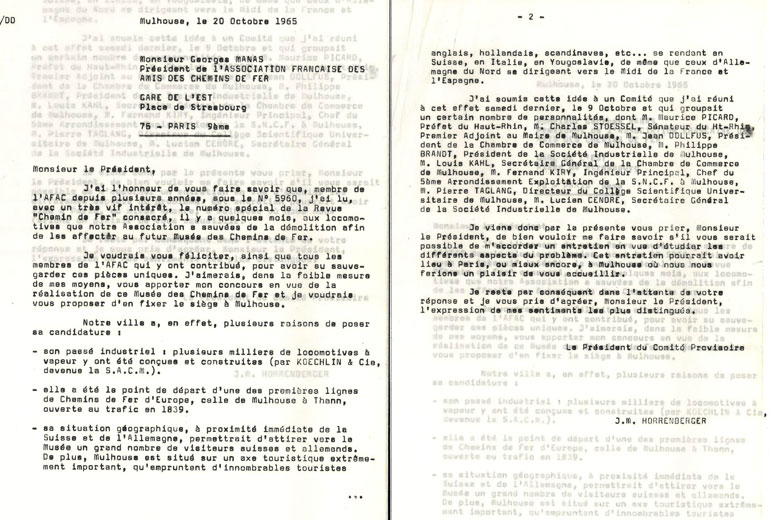
From Saône
to Doller
End of May 1966. 300 kilometres away from Mulhouse, the project picked up speed. In the roundhouse in Chalon-sur-Saône, a historic meeting took place between three men: Michel Doerr, Daniel Caire and Jean-Mathis Horrenberger. Charles Baschung, journalist from L’Alsace, sent specially for the event, gave an account in the newspaper of the almost cinematic nature of the meeting. The suspense was unbearable. Would Mulhouse be chosen? Time was short and other cities like Bordeaux, Compiègne and Reims or even Saint-Savin-Sur-Gartempe were also in the running. In his memoirs, Jean-Mathis Horrenberger tells of his astonishment at the extremely damaged condition of some of the material. The dream would not come true without a major financial cost. In that context, political support from the highest level in government seemed more necessary than ever.
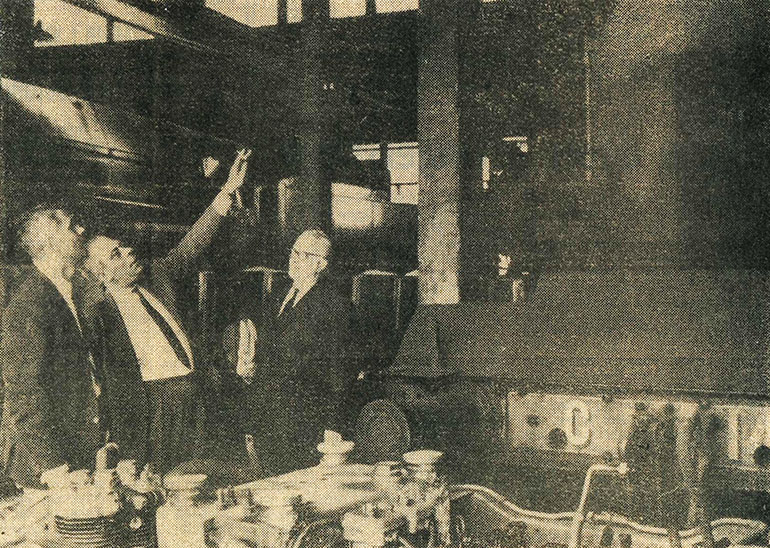
Political
support
On 28 July 1969, the news was good: SNCF had approved the choice of Mulhouse. A few words in the newspaper Dernières Nouvelles d’Alsace symbolised the success of years of negotiation. This selection of unpublished correspondence from the archives of the Cité du Train bears testimony to that event.
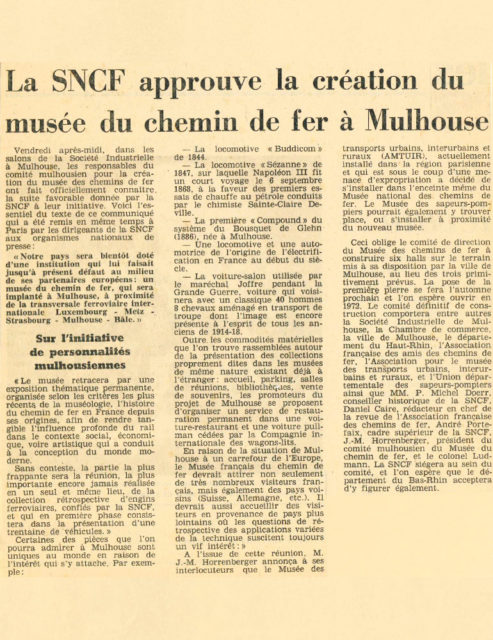
Quatre-Mares
lives up to its legend
“[…] missing parts, to be reconstructed with materials that are not identical to the original ones (for instance, puddled iron is no longer made), finishes that have disappeared and old fabrics that are not available, markings that have been forgotten, decorations that are terribly expensive if an “identical” reconstruction were to be attempted; all this for an object whose fairly long life has not been without modifications and even complete reworking. Which of the successive stages must be kept for posterity?”
Michel Doerr and André Portefaix
“Vers un Musée Français du Chemin de Fer”, 1970
As the owner of the original collection of the museum, SNCF also provided its expertise in the area of restoration. From 1967, the Buddicom Saint-Pierre, an iconic locomotive dating from 1844, thus moved to the workshop in Quatre-Mares. Located in Sotteville-lès-Rouen in Normandy, the workshop, now a “technology centre” proved its status as the inheritor of that inaugurated during the July Monarchy by two British engineers: William Allcard and William Barber Buddicom. Over a century after it was designed, the locomotive got back its number 33, which was removed during the first restoration in the early 20th century.
As pointed out by Michel Doerr and André Portefaix, chief engineer of the Equipment department, restoration must be thoroughly documented in advance, and must in theory put the train back as accurately as possible into its original condition. But the doctrine was not so easy to apply in practice…
The “gem” of
Romilly-sur-Seine
Trains as works of art. That could be title of the note sent by Michel Doerr to Jean-Mathis Horrenberger on 17 February 1969. In this letter, which uses the vocabulary of jewellery, the future director of the Museum described the progress of restoration work on the Class A 151 Nord first-class carriage. Praising the workers of Romilly, both active and retired, this letter also gives an idea of the diversity of the know-how required for restoring some rolling stock. Carpentry, cabinet making, boiler work, painting and textile work are some of the trades required for restoring this carriage to its past glory, an incarnation of the Second Empire style.
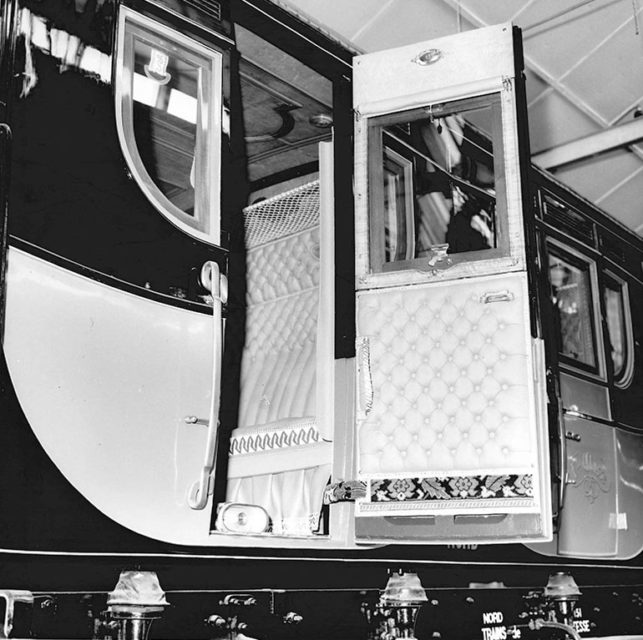
“A true gem […]
certainly and by far the finest of the restorations completed until now […]
“loving” supervision of the hands that restored it […]
wide temperature variations that are harmful for conservation […]
takes up its place in Mulhouse in an appropriate “temple”[…]”
– Quotes from the note sent by Michel Doerr to Jean-Mathis Horrenberger on 17 February 1969
Napoléon
and the mill
What would a museum be without its collection, its building, its staff, its visitors and also its logo? In July 1969, the railway painter Michel Lamarche got to work. His preparatory sketches show his wish to put together the three constituent elements of the future museum: trains, the building and Alsace. Presented by Michel Doerr in October 1969 at the constituent assembly of the Association pour le musée des chemins de fer de Mulhouse (AMCF Mulhouse), the pictogram was simplified. Before the scarlet wheel of the mill, famous as the emblem of Mulhouse, you can see a locomotive: the Koechlin Napoleon. The railways museum absolutely had to be in Mulhouse.
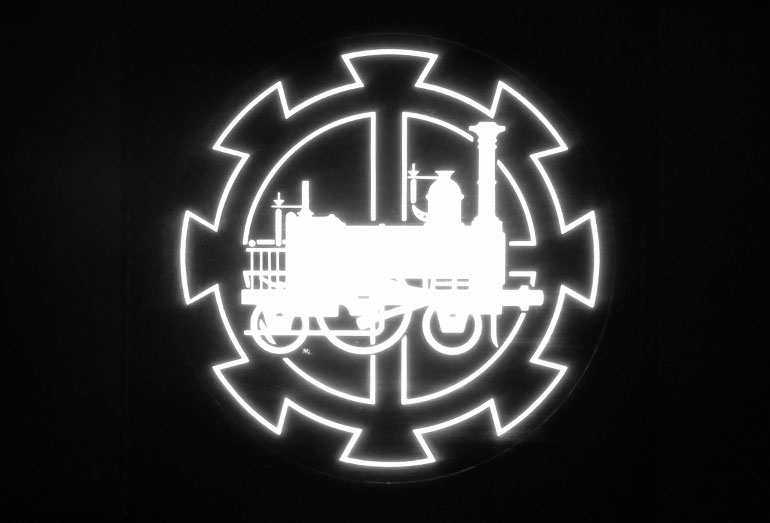
Formation of the museum organisation
14 October 1969. The meeting rooms of the Société Industrielle de Mulhouse were buzzing. The city, SIM, SNCF, the CCI, CIWLT, the local fire fighters organisation and AMTUIR were at the presentation of the articles of the Association du musée des chemins de fer de Mulhouse. Jean-Mathis Horrenberger and Michel Doerr, the essential protagonists of this Titanesque enterprise, were officially appointed President and Director of the future establishment. The signature was the result of many solicitations and interventions on the local and national level, and simultaneously marked the start of a huge project under the architect Pierre-Yves Schoen: that of the final museum, which would be inaugurated in Dornach seven years later in 1976.
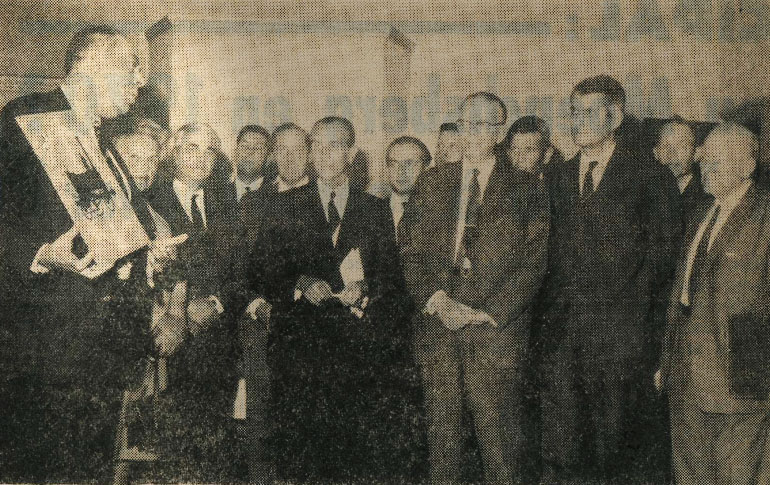
Number 1
Today, the museum contains equipment and objects provided by CIWLT, RATP, AMTUIR and La Poste, but SNCF is the owner of most of the collection. In October 1970, an honorary member’s card bearing the number 1 was sent to André Ségalat, then President of the company.
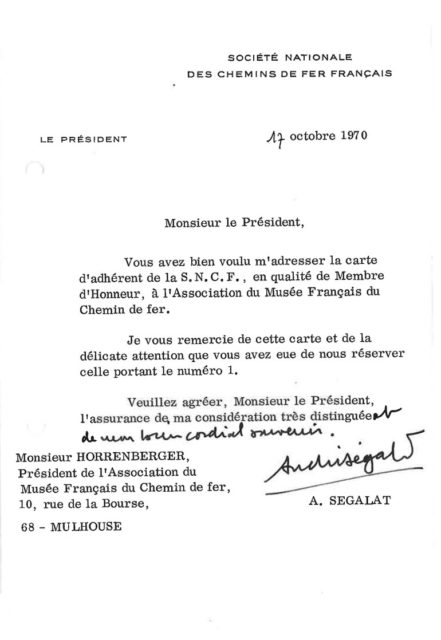
Life-size objects…
While some rolling stock continued to moult under wraps in the workshops of SNCF, other objects were already being shown to an admiring public. That was so of the Aigle, which was presented in December 1969 at the Children’s Fair in Le Bourget. The locomotive from 1846 was placed at the centre of the aisles between games, toys and booths dedicated to learning, and was a huge success. A few days before the Christmas holidays, it brought magic to young and old alike. Making La Vie du Rail ask this question: “Are the railways the best toy in the world?”
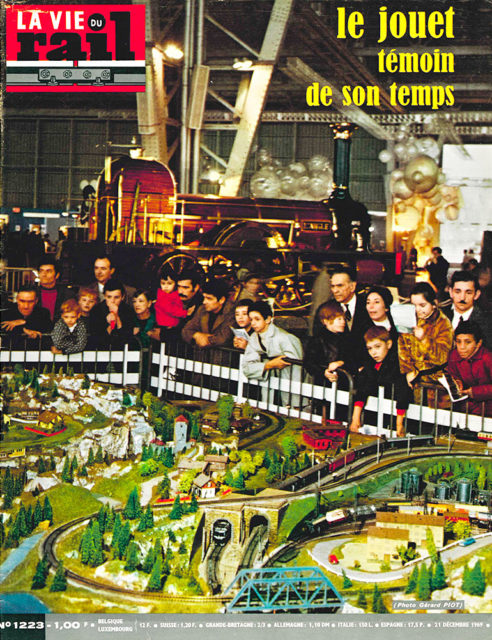
… and miniatures
The oldest locomotive conserved in Europe is also remarkable in this regard. Many still remember the Buddicom transistor set offered by La Vie du Rail that very same year. In plastic with steel innards, this object, which we would now call “merchandise”, paid tribute to the future star of the French Railways Museum. The advertisement even reassured the public that “it will not mar the decoration of your home”.
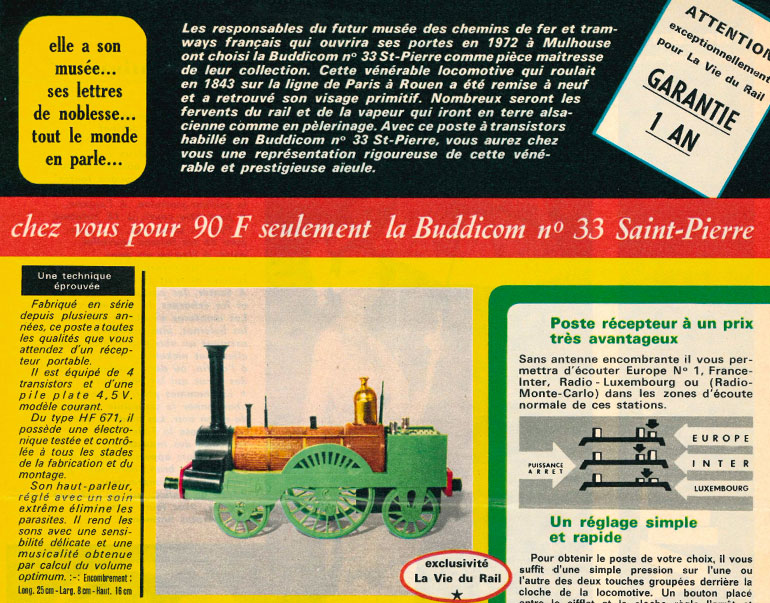
Founding of the Rail Miniature Club Alsace Sud (RAMCAS)
HO, N, 0, 1, Z, and G, the railways would be nothing without miniatures. Making these calls for a variety of skills: in railways, architecture, landscapes, observation, carpentry, painting, electronics and digitisation. The French Railways Museum could not afford to ignore these representations. The first meeting was in December 1970 at Chez Dondon, the place to be for miniature train lovers.
A group of fanatics met up in the shop, which used to be located in Rue Mercière, and set up the foundation stones of what would become the Rail Miniature Club Alsace Sud. The club, which was known as RAMCAS and was part of the museum, ceaselessly promoted its activity over the decades. In our times, every September, the Models Fair gives an ever wider public a chance to discover the miniature trains that are cleverly placed near their life-size counterparts.
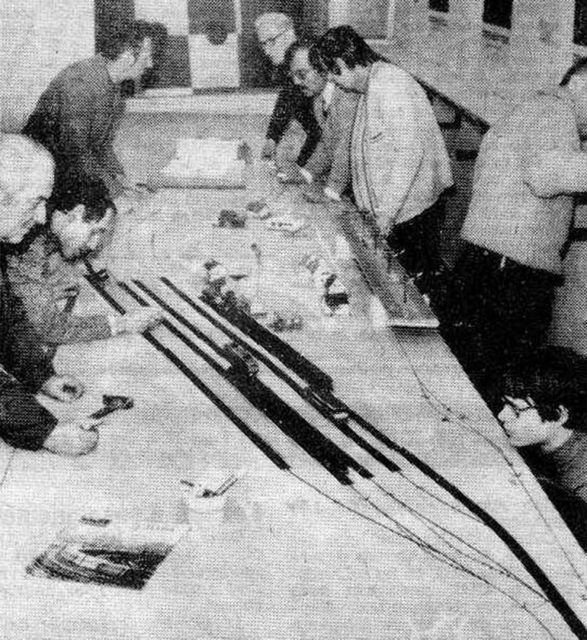
“Textile companies were being wiped out all the time, because they could no longer compete with companies in countries with low labour costs. We knew we had to find some other activities for our region. So why not take part in a new phenomenon that was emerging, which was beginning to be called the “leisure civilisation”?”
Jean-Mathis Horrenberger
in Le Musée Français du Chemin de Fer : une utopie devenue réalité, 1997
Mulhouse
in the 1970’s
The 1970s were a crucial period for the city of Mulhouse, particularly in the areas of society, town planning, architecture and culture. In 1968, the Mulhouse conference had laid down the bases for redefining the cultural and tourist policy of the town. Dialogue between the arts institutions in place, the new cultural scene and the development of infrastructure serving the city came to be seen as factors that would be required to keep it attractive.
The start of work on the autoroute A36 between Beaune and Mulhouse and the opening of a new passenger terminal in Basel-Mulhouse airport in 1970 were part of that drive. Symbolising the meeting between France, Germany and Switzerland the impressive reinforced concrete figure of the Tour de l’Europe, work of the architect and town planner François Spoerry, appeared in the capital of the Upper Rhine département at about the same time. A few kilometres away, work was beginning on the French Railways Museum…
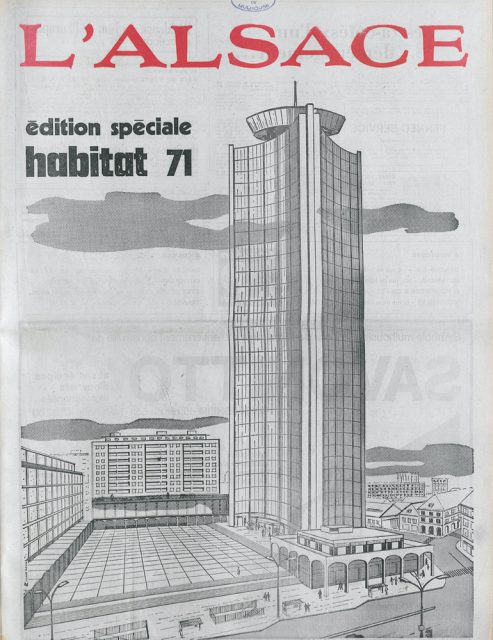
11 March 1971, Municipal library of Mulhouse
The half roundhouse of
the Mulhouse-North depot
From the late 1960s, the architect Pierre-Yves Schoen had begun preparing plans for what would become the final museum in Mulhouse-Dornach in 1976. Between 1971 and 1976, one of the half roundhouses of the Mulhouse-North depot was selected to shelter the temporary exhibition of the French Railways Museum.
Located in a marshalling yard built in 1889, the building, which has now been destroyed, offered the advantage of allowing the easy movement of the first trains in the collection, while displaying them in their “natural environment”. That convenience in terms of display had to address the need for handling visitors.
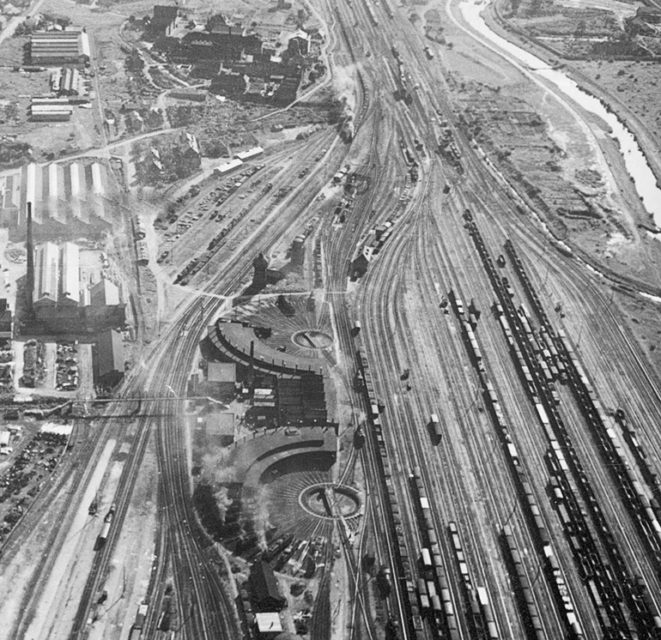
In an interview he gave to a journalist from L’Alsace on board a Turbotrain in September 1970, Jean-Mathis Horrenberger disclosed some secrets of the railway museum project. After presenting the conditions agreed by SNCF and AMFCF regarding the temporary use of the place, the President said that over 8000 members’ cards had been sent out across the country. Seven months later, in April 1970, building work began. Fencing, a transformer, a ticket office, accesses for museum personnel, connection between the access way and the reception space were some of the stages of work in the months prior to opening to the public.
The grand
opening!
Covers were taken off the locomotives, equipment was dusted, staff employed, signboards put up…
On 12 June 1971, the French Railways Museum in Mulhouse opened its doors to the public, every day from 10 am to 6 pm.
On 3 July, the museum, which would be the biggest of its kind in Europe, was inaugurated officially.
